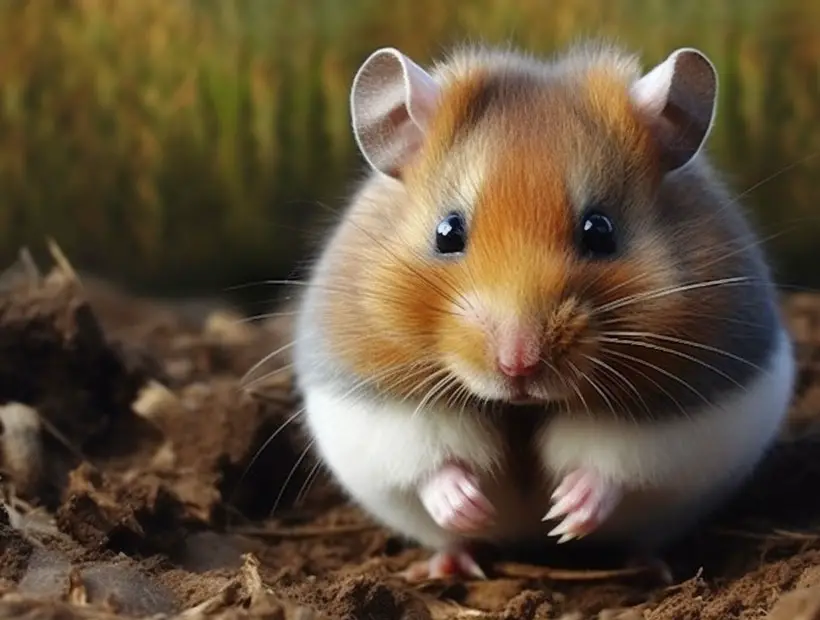German Hamster Care: Food, Habitat, Health, and Facts + Expert Tips
Ever considered getting a hamster as a pet? You should adopt a German hamster. Why? These adorable, small creatures can make excellent companions. But you should remember that they do require proper care to thrive.
But how to care for German hamsters? You simply need to choose the correct food, habitat, and lifestyle for them. This keeps them happy, healthy, and thriving.
Therefore, in this ultimate guide, we’ll explore everything you need to know about German hamsters’ care. We’ll talk about their diet, habitat, health, and many more. So, read on to learn about German Hamsters’ care in detail.
1. Designing the Ideal Habitat for German Hamsters
Let’s make a nice living arrangement for our furry friend. You have to ensure the following things to make a better habitat for your pet hamster.

A. Cage Size and Material Recommendations:
German hamsters need spacious rooms to roam. So,
- Opt for a cage that is at least 24 inches long, 12 inches wide, and 12 inches high. This size is applicable for a single mature hamster. If you want to have more, enlarge the cage by multiplying the dimensions accordingly.
For instance, if you have three hamsters, you will need a cage that is 24×3 inches long, 12×3 inches wide, and 12×3 inches high.
- Choose a sturdy material like metal, glass, or hard plastic to prevent escape attempts or injuries.
- Bar spacing should be no more than ½ inch apart to keep your little explorer safe.
B. Bedding and Nesting Materials
Your hamster needs soft, absorbent bedding to burrow and nest in. Aspen shavings, cellulose fiber, or paper-based materials for bedding are all perfect options.
Never use shavings from cedar or pine trees because they can cause respiratory issues. Provide nesting materials like unscented tissues or shredded paper for added comfort.
C. Enrichment and Toys
Can you imagine life without entertainment? German hamsters are intelligent creatures that need mental stimulation, too.
So, provide toys like wooden chews, cardboard tubes, and hideouts to keep them engaged. Climbing structures and puzzle toys are also great for encouraging exploration and problem-solving skills.

Here are some examples of these toys and how they can be of use:
Climbing structures:
- Wooden ladders: These can be attached to the cage to create a multi-level environment. This will allow your hamster to climb and explore.
- Branches and ropes: Natural branches or ropes can be hung horizontally or vertically. This is for your hamster to climb on and exercise its grip strength.
Puzzle toys:
- Treat balls: Fill these toys with your hamster’s favorite treats. They’ll have to manipulate the ball to release the treats. So, they’ll get mental stimulation and a tasty reward.
- DIY toys: Create your own puzzle toys using cardboard tubes, boxes, or egg cartons. By hiding treats inside these, let your hamster figure out how to access them.
Foraging toys:
- Scatter feeders: These toys encourage your hamster to search for their food, mimicking natural foraging behavior.
- Digging boxes: Fill a container with substrates, such as coconut fiber or shredded paper. Then, hide treats inside for your hamster to dig up and find.
D. Exercise Equipment
A well-exercised hamster is a happy hamster.
So, provide a solid-surface exercise wheel that’s large enough for your German hamster to run. Remember, the size must be big so your pet can run without arching its back.
E. Proper Location and Temperature Control
Choose a quiet, low-traffic area of your home to place the cage away from direct sunlight and drafts.
Hamsters are sensitive to temperature fluctuations. They go into hibernation if the temperature drops below 5° C (41° F), according to instructions provided by the University of Kentucky. So, maintain a consistent environment between 65-75°F (18-24°C).
2. Feeding Your German Hamster: Nutrition and Diet
Offering a proper diet is the main part of caring for your hamster. Let us help you out with that:

A. Essential Nutrients and Food Groups
A balanced diet is critical for your hamster’s well-being. They require a mix of:
- Proteins (at least 18% as suggested by the National Institutes Of Health).
- Healthy fats
- Carbohydrates
- Vitamins
- Minerals.
B. Commercial Food Options and Recommended Brands
High-quality commercial hamster food can provide a solid nutritional foundation. Opt for a lab block or pellet formula because they prevent selective feeding. Some reputable brands include Oxbow, Mazuri, and Higgins Sunburst.
C. Fresh Foods, Treats, and Supplements
In addition to commercial food, offer small portions of fresh fruits, vegetables, and grains.
Here are some specific suggestions that you should try:
Fresh Foods:
- Vegetables: Hamsters can eat a variety of vegetables, such as carrots, broccoli, kale, spinach, and bell peppers. Offer small amounts and make sure they are cut into small pieces.
- Fruits: Small amounts of fruits, such as apple slices, bananas, and strawberries, can be given as a treat.
- Herbs: Fresh herbs like parsley, cilantro, and basil can be given to hamsters in small amounts. These can provide additional vitamins and minerals.

Treats:
- Dried fruits: You can give dried fruits like apricots, raisins, and cranberries as a treat.
- Seeds and nuts: Treats like sunflower seeds, pumpkin seeds, and unsalted nuts like almonds or peanuts can provide protein and healthy fats.
Supplements:
- Vitamin C: Hamsters cannot produce their own vitamin C. So, supplementing with small amounts of fresh bell pepper or a vitamin C supplement can help prevent deficiencies.
- Calcium: Hamsters also need calcium to support their bones. So, a calcium supplement can be offered in the form of a cuttlebone or mineral block.
- Probiotics: Adding a small amount of probiotic-rich food like plain yogurt to your hamster’s diet can help promote digestive health.
Remember to introduce these foods gradually. Offer occasional treats like mealworms or yogurt drops, but don’t overdo it.
3. Health and Wellness: Common Issues and Preventive Care
You must know the following facts to keep your German critter friend in good health.
If you notice any of these signs in your hamster excessively, seek professional help from a veterinarian before it gets out of hand.

A. Common Health Issues and Preventive Measures and Tips
Here are some common issues that German hamster owners face and how to prevent them:
1. Dental Problems:
Hamsters have teeth that continuously grow throughout their lives. This means they require appropriate dental care to prevent overgrowth, which can lead to dental problems.
Preventive Action:
Providing chew toys such as wooden blocks and sticks and offering a balanced diet rich in fiber can help prevent dental issues.
2. Respiratory Issues:
Hamsters are susceptible to respiratory infections. This can cause symptoms such as wheezing, sneezing, or coughing.
These can be caused by a variety of factors, such as stress, exposure to cold temperatures, or poor ventilation.
Preventive action:
Good hygiene, proper ventilation, and a clean living environment can help prevent respiratory issues.
3. Digestive Issues:
Hamsters can develop digestive issues such as diarrhea or constipation. This can be caused by a variety of factors such as improper diet or stress.
Changes in the appearance or frequency of stool can also be a sign of illness.
Preventive action:
Providing a balanced diet rich in fiber, fresh foods, and clean water can help prevent digestive issues.

4. Skin and Fur Problems:
Hamsters can develop skin and fur problems such as infections or allergies.
Skin irritation, hair loss, or excessive grooming are also signs of skin or fur problems in hamsters. This can be caused by a variety of factors, including parasites or mites.
Preventive action:
Providing a clean living environment, good hygiene, and regular grooming can help prevent skin and fur problems.
If you notice any signs of skin irritation, hair loss, or excessive grooming, seek veterinary care to address the issue.
5. Obesity:
Hamsters can become overweight or obese, which can lead to health problems. Such as, diabetes, heart disease, and joint problems.
Preventive action:
Providing a balanced diet, proper portion control, and exercise can help prevent obesity in hamsters.
6. Changes in behavior or activity level:
Hamsters are generally active creatures. So, lethargy, lack of appetite, or decreased interest in normal activities such as running on the wheel can be signs of illness.
Preventive action:
Let your hamsters spend some time in the garden or the backyard. A little touch of nature will help to maintain good health.
7. Eye and ear issues:
Swelling, abnormal levels of discharge, or excessive redness around the eyes and in the areas near the ears can indicate a bacterial infestation. Hamsters can also develop ear infections, which can cause head tilting or loss of balance.
Preventive action:
Visit a vet once in every month to inspect your pet before it gets an infection. Make sure you give your pet proper meds beforehand.
B. Safe Handling and Hygiene Practices
Now, let’s talk about proper handling and correct hygiene practices. Here’s what you can do.

1. Wash your hands:
Before touching your hamster, always wash your hands with unscented soap to remove any germs. This will prevent the transfer of foreign scents that might stress your hamster out.
2. Let them sniff you:
Allow your hamster to sniff your hand, so they can get used to your scent. This will help them feel more comfortable with you.
3. Scoop, don’t grab:
When picking up your hamster, gently scoop them up from underneath, supporting their entire body. Avoid grabbing them from above, as this may frighten them.
Now, let’s dive into hygiene practices for your German hamster:
- Cage cleaning: Clean your hamster’s cage at least once a week. This includes replacing bedding, wiping down surfaces, and washing any toys or accessories.
- Spot cleaning: In between full cleanings do some spot cleaning to remove soiled bedding and any leftover food.
- Grooming: German hamsters are generally good at grooming themselves, but you can help by providing a sand bath.
Get a shallow dish and fill it with chinchilla sand (not dust). Then, let your hamster roll around in it. This helps remove excess oils and keeps their coat clean.
Breeding German Hamsters: Best Practices and Considerations

Breeding hamsters requires time, resources, and a deep understanding of their needs. So, consider the responsibility before deciding to breed your hamster.
- Selecting Suitable Mates: Choose healthy, unrelated hamsters with good temperaments for breeding.
- Proper Breeding Environment: Provide a clean, spacious, and stress-free environment for the breeding pair. Be prepared to separate them if aggression occurs. What’s more, have a plan in place for housing the offspring.
- Pregnancy, Birth, and Newborn Care: Monitor the pregnant female closely, and provide a nesting box for her to give birth. Once the pups are born, minimize handling and disturbance to ensure their well-being.
Common German Hamster Behavior Issues Management

How to keep your pet hamster on good behavior? Let’s find out:
A. Biting and Aggression
Hamsters may bite if they feel threatened or stressed. Identify the triggers, and work on building trust and reducing stress in their environment.
B. Bar Chewing and Cage Escapes
A report from RSPA (based in the UK) says that Boredom and stress can lead to bar chewing, gnawing and escape attempts. So, provide ample enrichment, toys, and secure habitat to prevent these behaviors.
C. Nocturnal Activity
Hamsters are naturally nocturnal, so expect some nighttime activity. It’s normal. So, there’s nothing for you to do about it.
If you’re interested in learning more about hamster care, you might find our articles on Chinese dwarf hamster care and hamster behavior helpful. Our article on Chinese dwarf hamster care provides valuable information on the specific needs, habitat, and health considerations for this particular hamster species. Additionally, our article on hamster behavior explores the fascinating behaviors and habits exhibited by hamsters, shedding light on their communication, nesting, and feeding patterns. These articles offer valuable insights for hamster owners looking to provide the best care for their furry friends.Frequently Asked Questions
At this point, let’s take a look at some common questions that you may have:
1. What are some things I should avoid doing with my German hamster?
Some things you should avoid doing with your German hamster include:
- Picking up your hamster by its tail.
- Putting more than 2 pairs of hamsters in a cage.
- Overfeeding your hamster or giving your hamster too many treats.
- Shouting at your hamster.
2. What food does a German hamster love the most?
They naturally have a tendency to have a sweet tooth and are particularly fond of fresh fruits. So, naturally, their favorite fruits include apples, bananas, and berries.
In addition to fruits, German hamsters also enjoy fresh vegetables such as carrots, bell peppers, and lettuce.
3. What times do I feed my hamster daily?
Hamsters are nocturnal animals and are most active during the night. So, we recommend feeding them once a day, usually in the evening, to coincide with their natural feeding patterns.
Then, offer your hamster a small amount of fresh food and water in the evening and remove any uneaten food the next morning.
Parting Words
Owning a German hamster can be a rewarding experience, as long as you’re committed to providing them with the care and attention they need. By following the guidelines and expert tips in this guide, you can ensure a happy, healthy life for your furry friend.
Make sure the proper habitat and diet for your German hamsters. Also, keep monitoring your pet’s health. If you notice any unwanted change in its behavior, consult your vet soon to identify if your hamster faces any health issues.





